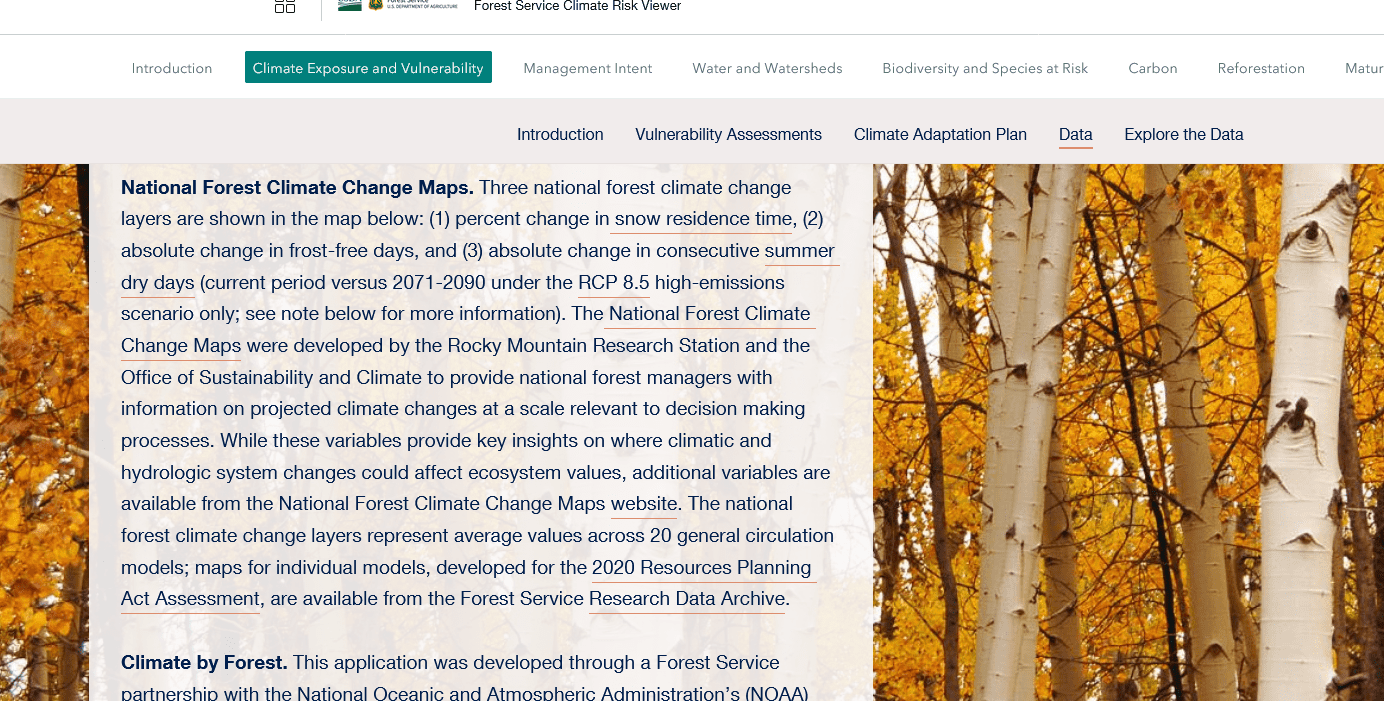The Secretary’s Memo directs the Forest Service to spatially identify wildfire and climate change-driven threats and risks to key resources and values in the National Forest System, including water and watersheds, biodiversity and species at risk, forest carbon, and reforestation. Further, section 2 of E.O. 14072 specifically directs Federal agencies to identify mature and old forests on Forest Service and Bureau of Land Management (BLM) lands.
Through this ANPRM, USDA is sharing the beta version of a new Forest Service Climate Risk Viewer ( https://storymaps.arcgis.com/collections/87744e6b06c74e82916b9b11da218d28) for public feedback (see Section 1 below). This beta version was developed with 38 high-quality datasets and begins to illustrate the overlap of multiple resource values with climate exposure and vulnerability. The viewer also includes current management direction on National Forest System lands. The viewer allows for a place-based analysis of the need for climate adaptation to maintain, restore, and expand valued forest ecosystem and watershed characteristics. Additionally, the viewer supports identification of gaps between current management and potential conservation and adaptation practices. The beta version of the mature and old-growth (MOG) inventory that is being developed pursuant to E.O. 14072 and the RFI for MOG is also being released to help inform policy and decision-making on how best to conserve, foster, and expand the values of mature and old-growth forests on our Federal lands. Core information from the MOG inventory has been integrated into the viewer.
I took a brief look and it was very complex. With a lot of RCP 8.5. So I will take some time and dig in for my own area, and hope others will do the same.
Synchronistically, Roger Pielke Jr. just posted a piece on his Substack this AM on another topic, but I think his thoughts are relevant to these maps.
Question 1: What scenarios are used to produce the estimates?
As frequent readers here will well know, the choice of scenario used in a climate projection can make the difference between an apocalyptic-looking future and one that appears much more manageable. You won’t be surprised to learn that many, if not most, studies that project future public health impacts of climate change rely on extreme, implausible or even impossible scenarios.
Question 2: How your analysis factor in adaptation?
One of the most incredible success stories of science, technology and policy over the past century has been the incredible progress around the world in improving adaptative capacity to weather and climate. This success story rarely gets reported on but that makes it no less real. There is of course more to do and continuing efforts are needed to maintain the progress made to date.
One dirty little secret in most studies of the future impacts of climate change (and not just on the effects of changes in extreme temperatures) in that future adaptation to climate variability and change is simply left out of projections. Assumptions are made that the climate will change, but people’s behavior will not. This is not how the real world works.
Adaptation- that’s the world of the natural resource professional. Wildland fire technologies and people, and so on. That’s us. We’re not included.
Note: I am absolutely not criticizing the FS nor the USDA for doing it this way. They have to do what they are told, and use existing stuff. They have to go with the flow.
At the same time, in our quest to understand whether that information has any value, we need to take Roger’s points into consideration. And as I’ve said before, no one understands how populations of organisms will respond to any changes. So there’s that.

“Assumptions are made that the climate will change, but people’s behavior will not. This is not how the real world works.”
This conveniently (and rather arrogantly) ignores how the real world seems to be working with climate change. That is that humans are not disposed to change their behavior until reality hits them in the face (which hasn’t happened yet to a lot of the people), and the lag times between that and any affect on the climate make it very believable that needed changes in human behavior would be too late.
That is why I am unafraid of humans “overdoing” climate change mitigation (and why I don’t appreciate those who try to come up with reasons to do less).
Um.. no.. I think he’s talking adaptation. Like they assume that engineers won’t redesign, that plant breeders won’t breed, that farmers won’t grow different crops, and so on.
You’re right that he says he is talking about adaptation. But I also don’t like the idea of making long-shot (or at least highly uncertain) bets when you’re betting the house.